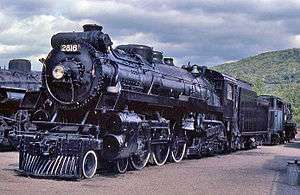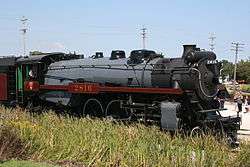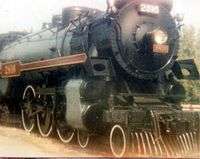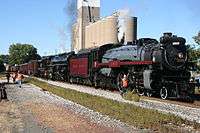Canadian Pacific 2816
Canadian Pacific 2816, also known as the "Empress", is a preserved class "H1b" 4-6-4 "Hudson" type steam locomotive built by the Montreal Locomotive Works (MLW) in 1930 for the Canadian Pacific Railway (CPR); the only non-streamlined H1 Hudson to have survived into preservation.
| Canadian Pacific 2816 | |||||||||||||||||||||||||||||||
|---|---|---|---|---|---|---|---|---|---|---|---|---|---|---|---|---|---|---|---|---|---|---|---|---|---|---|---|---|---|---|---|
CPR 2816 Empress on an excursion in 2008. | |||||||||||||||||||||||||||||||
| |||||||||||||||||||||||||||||||
| |||||||||||||||||||||||||||||||
| |||||||||||||||||||||||||||||||
| |||||||||||||||||||||||||||||||
After being used for heavy passenger service, the locomotive was retired in 1960 and donated to Steamtown, U.S.A. at Bellows Falls, Vermont, in 1964. After an extensive restoration, the locomotive returned to service in 2001 and was used by the Canadian Pacific Railway in occasional excursion service until the discontinuation of the steam program in 2012. Since then, the locomotive has been stored in Calgary, Canada.
First career
No. 2816 was one of ten H1b-class (the "H" meant the 4-6-4 wheel configuration, the "1" was the design number and the "b" meant it was the second production run) 4-6-4 "Hudson" type built by the Montreal Locomotive Works in late 1930.[1] It was first assigned to the line between Winnipeg and Fort William, Ontario.[1] Later, it was transferred to service between Windsor, Ontario, and Quebec City, and finally it ran a commuter train between Montreal and Rigaud, Quebec.[1] It made its last run on May 26, 1960, after more than 2 million miles (3.2×106 km) in active service.[2] In January 1964, the locomotive was sold to Steamtown, U.S.A., which evolved into the Steamtown National Historic Site in 1986.[1]
Restoration
When Steamtown, U.S.A. moved from Bellows Falls, Vermont, to Scranton, Pennsylvania, in the 1980s, No. 2816 was relocated to the new site with the rest of the collection.[1] When the National Park Service took over from the Steamtown Foundation, No. 2816 moved to the Steamtown National Historic Site, and the NPS decided to divest itself of foreign locomotives.[1] In September 1998, the Canadian Pacific purchased No. 2816 after hearing of its availability from the crews who were running the Royal Hudson No. 2860, who had been looking for parts for 2860 and were offered the entire locomotive.[3]
The locomotive was transported from Scranton to Montreal via Binghamton and Albany, New York, before being shipped cross country to the BC Rail steam shops in Vancouver for restoration. The locomotive was completely stripped down and rebuilt, "the most thorough rebuild undertaken on a steam locomotive in North America since the end of their era" according to CPR News.[4] The restoration team was able to use over 800 technical drawings of CPR Hlb class locomotives from the Canada Science and Technology Museum to completely restore 2816 to its 1950s appearance and to its original specifications.[4] During restoration, the locomotive was converted to burn oil and equipped with modern amenities such as a radio and a diesel control unit. The restoration took over two years and cost over $2,000,000, making it one of the most costly locomotive restorations in Canada. CPR was confident in the restoration enough to announce on April 19, 2000, that 2816 would become an ambassador for the railway in the railway's new heritage steam program.[2]
Excursion career
In September 2001, the locomotive made its first trial run from the BC Rail steam shops to its new home of Calgary, Canada.[5] It then rejoined the Canadian Pacific fleet as a special excursion locomotive and for public relations. Among other uses, 2816 is used to raise money for school lunch programs and the Children's Wish Foundation.[6]
Between 2001 and 2012, 2816 traveled across Canada and the United States. Today, the 2816 is one of the most well-known steam excursion locomotives in North America, along with Union Pacific 844, Union Pacific 3985, Union Pacific 4014, Southern Pacific 4449, Santa Fe 3751, Milwaukee Road 261, Norfolk & Western 611, Norfolk & Western 1218, Frisco 1522, Chesapeake & Ohio 614, Pere Marquette 1225, Nickel Plate Road 765, Southern Railway 630, Southern Railway 4501 and Royal Hudson 2860.
At the end of the 2008 season, Canadian Pacific put the steam program on hold (with exception of previously promised engagements) due to financial issues caused by the poor economy. 2816 did not operate at all in 2009, although the steam program was able to take advantage of this down time to do some extensive maintenance work on 2816 and its passenger car fleet. 2816 returned to operation on June 6, 2010. It was used in Rocky Mountain Express, a 2011 IMAX film which follows the locomotive on a journey from Vancouver to Montreal while telling the CPR's history.
In late 2012, Canadian Pacific CEO Fred Green stepped down and E. Hunter Harrison succeeded him.[7] Harrison had no interest in running steam locomotive operations and discontinued the steam program,[7] forcing No. 2816's excursion operations to be ceased and the locomotive placed in storage in Calgary, Canada.[7] Even after Harrison stepped down in early 2017, being succeeded by Keith Creel,[8] the locomotive remains in storage.
Preservation and other remaining H1 Hudsons
Of the five surviving Canadian Pacific Hudsons out of the original 65 built between 1929 and 1940, the 2816 is the only survivor of the non-streamlined H1a and H1b classes built in 1929 and 1930 numbered 2800–2819.[1] The four other remaining sister engines to 2816 are the semi-streamlined Royal Hudsons numbered 2820–2864. The remaining 4 Royal Hudsons are numbers 2839 (H1c), 2850 and 2858 (both H1d) and the 2860 (H1e). Currently, 2816 and 2860 are the only 2 operating 4-6-4 Hudsons in North America; no American 4-6-4 Hudsons are operational.
Gallery
 CP No. 2816 on static display at Steamtown, USA Bellows Falls, Vermont, C. 1978
CP No. 2816 on static display at Steamtown, USA Bellows Falls, Vermont, C. 1978.jpg) The engineer's side of 2816's control cab.
The engineer's side of 2816's control cab. The Canadian Pacific 2816 Empress at a stop in Sturtevant, Wisconsin, September 1, 2007.
The Canadian Pacific 2816 Empress at a stop in Sturtevant, Wisconsin, September 1, 2007. CPR 2816 on static display at Steamtown, USA Bellowsfalls. VT, C. 1974
CPR 2816 on static display at Steamtown, USA Bellowsfalls. VT, C. 1974 CPR 2816 doubleheading with Milwaukee Road 261 on Sept. 15 2007.
CPR 2816 doubleheading with Milwaukee Road 261 on Sept. 15 2007.
References
- "Canadian Pacific Railway No. 2816". National Park Service. Archived from the original on March 2, 2019. Retrieved March 2, 2019.
- Stephens, Bill (July 2000). "CP 4-6-4 2816 to head program". Trains. Waukesha, WI: Kalmbach Publishing. 60 (7): 20. ISSN 0041-0934.
- Smith, Ian (October 2001). "CPR 2816 Reborn for 21st-Century Service" (PDF). Branchline. Bytown Railway Society. pp. 8–9. Archived from the original (PDF) on March 4, 2019. Retrieved March 4, 2019.
- "Rebirth of a mechanical Wonder". CPR News (2). 2001.
- "CPR 2816 Back in Steam After 40 Years" (PDF). Canadian Rail. Canadian Railroad Historical Association. January–February 2002. p. 3. Archived from the original (PDF) on March 31, 2016. Retrieved February 27, 2019.
- "2816 Empress steam train launches tour benefiting the Children's Wish Foundation of Canada". May 24, 2011. Archived from the original on March 14, 2012. Retrieved March 11, 2012.
- Gunnoe, Chase (November 19, 2015). "CP or NS: which has a soul for preservation?". Trains. Archived from the original on February 25, 2018. Retrieved February 27, 2019.
- "Canadian Pacific Railway says CEO Hunter Harrison stepping down immediately". CBC News. January 18, 2017. Archived from the original on January 18, 2017. Retrieved April 27, 2019.